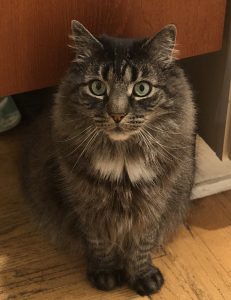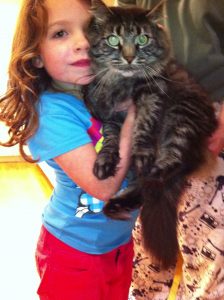
But first, we have a cat named Teddy. Ted is a rescue cat. He spent the first years of his life roaming the mean streets of Fresno, California. We got him (or more appropriately, he got us) in February of 2009, almost ten years ago. Based on the wear on his pads, the vet figured he was two or three years old at the time of adoption, making him 12 or 13 years old now. While he won’t chase the red dot from a laser pointer the way he used to, he’s hardly lost a step and, as the recent photo above attests, he still looks

The Tedster is a Maine Coon: a landrace (or “natural breed”) native to the state of Maine. (A landrace is a type plant or breed of animal that over time naturally adapts to its environment. In the case of the Maine Coon that environment is a cold, snowy, and icy one, necessitating long, thick hair; big feet; and a huge, bottlebrush-like tail.) He is extraordinarily friendly to everyone – family, friends, and strangers – without being needy or clingy. In the presence of other cats and the occasional dog (visitors to our house), he calmly holds his ground and never bristles, strikes out or hisses back when he is hissed or barked at. My daughter Lily refers to him as “Steady Eddie”, and that he is: cool as a cucumber, smooth as a peeled onion, slick as snail slime on a bowling alley. He is smart, loyal, and looks out for his “people”. He waits by the door when we are out and stays close when we are at home. He was amazingly gentle with my kids when they were in diapers; when they got out of hand or were too rough he’d tap one of their cheeks lightly with a paw, a warning that was always heeded. Ted likes to chat and while doing so he’ll make eye contact; at such moments it’s easy to forget that he’s a cat.
And thus the Tedmeister is often paid the highest compliment any cat can receive: he thinks he’s a dog.
I’ve always thought it ironic that the nicest thing anyone can say about a cat is that it doesn’t act like a cat but rather, like another species altogether.
The same thing is true for written histories.
(Aha! So this is where he’s been going!)

If we think about it for a moment, the nicest thing anyone can say about a written history is that it reads like a novel.
We consider. “Histories” are all-too-often chronological catalogs of names, dates, and events; information-rich but tedious soporifics that can put-to-sleep even the most chronic insomniacs.
Conversely, novels tell stories, stories that are perceived as being entertaining, stories that are being told by professional writers.
So when we say a written history reads like a novel, we’re saying, one, that the history contained therein has been woven into a compelling narrative; two, that narrative is actually fun to read; and three, that the historian who wrote the narrative writes like a pro.
Which brings me to the Dr. Bob prescription – a trilogy of Franz Liszt biographies which read like an epic novel on the lines of War and Peace and Gone With the Wind, because it is not just about Liszt – who was almost certainly the greatest pianist who ever lived and a great composer as well – but about Liszt’s world:
Learn more about the trilogy – the author, and even more about Ted the Cat on Patreon
